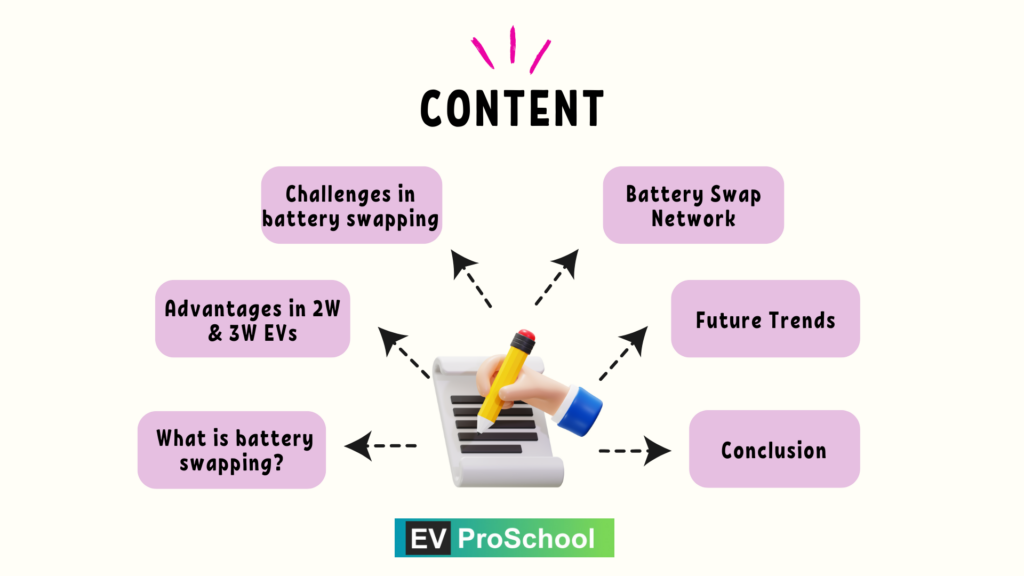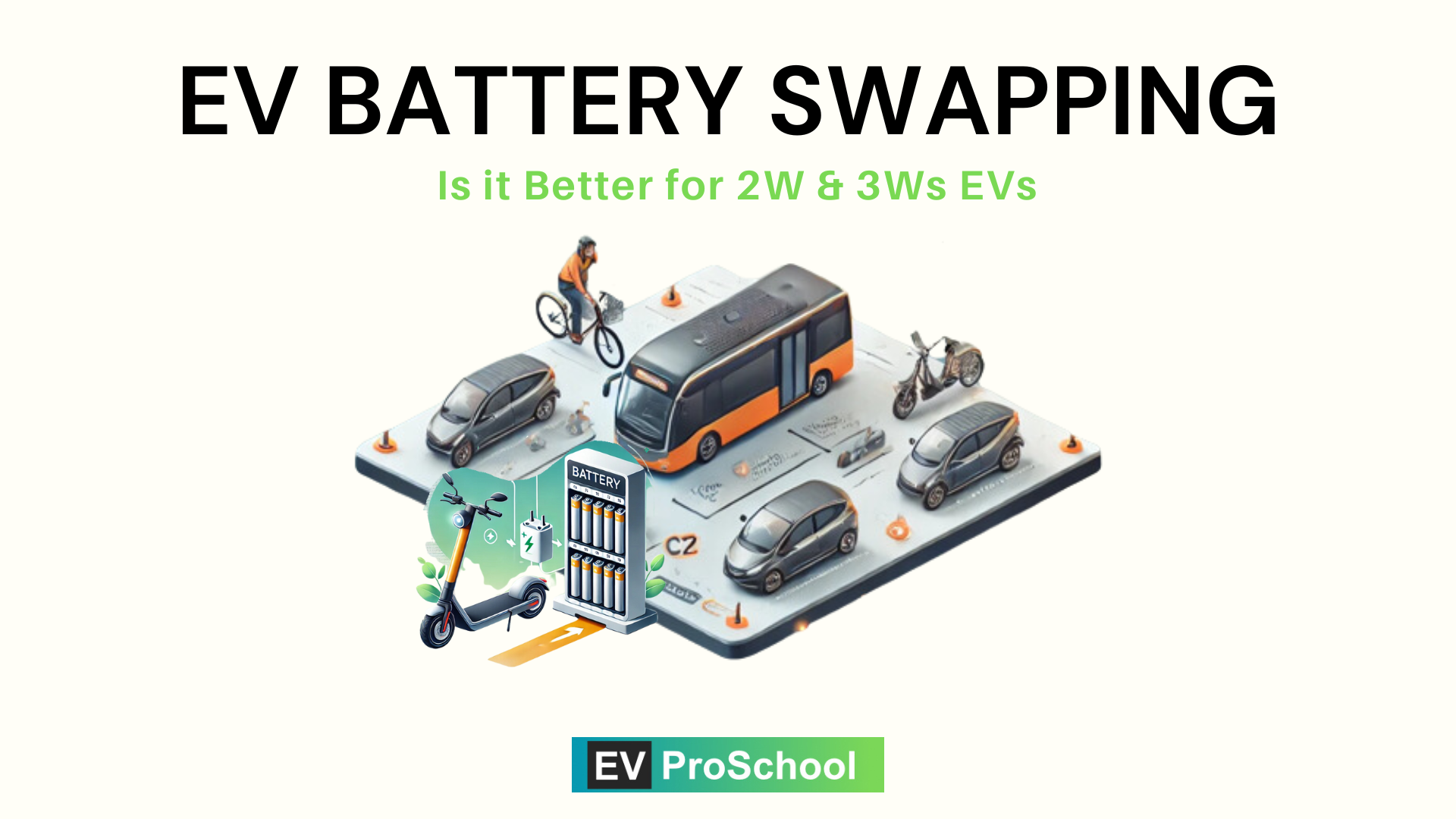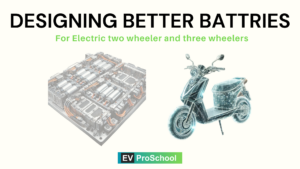This blog post will focus on battery swapping as an innovative alternative to traditional charging methods, with a specific emphasis on its adoption in 2W and 3W EVs. It will explore the technology behind battery swapping, its advantages and challenges, and real-world examples such as NIO, Gogoro, and Indian swapping stations. The blog will avoid overlapping with previous topics and will instead highlight future trends, market potential, and business models shaping battery swapping.

1. Objectives
Purpose:
- To explain how battery swapping works and its role in enhancing EV adoption for 2W and 3W vehicles.
- Discuss its advantages (e.g., time efficiency, reduced charging infrastructure costs) and challenges (e.g., standardization).
- Showcase global and Indian examples of battery swapping networks to illustrate its potential.
Target Audience:
- Urban commuters and fleet operators interested in reducing EV downtime.
- Startups and businesses exploring battery-as-a-service (BaaS) models.
- Policymakers and investors focusing on EV adoption in cost-sensitive markets.
2. Blog Outline
Title Options:
- Main Title: Battery Swapping: How It Works and Its Future in 2W/3W EVs
- SEO-Friendly Title: The Future of Battery Swapping in Electric 2W and 3W Vehicles
Introduction: Revolutionizing Charging for Small EVs
- Hook:
“What if charging your EV was as quick as refueling a gas vehicle? Battery swapping makes this vision a reality.” - Set the stage: Explain the growing popularity of 2W and 3W EVs for urban transport and the need for fast, reliable energy solutions.
- Preview the blog: “This post explores how battery swapping works, its advantages and challenges, and the future of this game-changing technology in the 2W/3W EV market.”
Section 1: What Is Battery Swapping?
- Definition:
- Battery swapping involves replacing a discharged battery with a fully charged one at a swapping station.
- The process takes a few minutes, eliminating the need for waiting during charging.
- How It Works:
- Users drive to a swapping station, exchange their battery, and continue their journey.
- Operated via subscription-based models or pay-per-swap systems.
Section 2: Advantages of Battery Swapping for 2W and 3W EVs
1. Time Efficiency
- Swapping takes less than 5 minutes compared to several hours for charging.
- Ideal for delivery fleets and e-rickshaws with high utilization rates.
2. Reduced Downtime
- Vehicles spend more time on the road, increasing productivity for businesses.
3. Lower Upfront Costs
- Users buy EVs without batteries, significantly reducing purchase prices.
- Battery-as-a-Service (BaaS) eliminates battery ownership costs.
4. Scalability
- Battery swapping stations require less space and infrastructure than charging stations, making them ideal for densely populated urban areas.
Section 3: Challenges Facing Battery Swapping
1. Standardization
- Lack of uniformity in battery sizes and connectors across manufacturers.
- Need for standardized battery packs to ensure compatibility.
2. Battery Degradation Management
- Ensuring swapped batteries have consistent performance and lifespan.
3. High Initial Investment
- Setting up swapping networks requires significant capital investment.
4. Limited Awareness and Adoption
- Educating users about battery swapping benefits and addressing concerns over reliability.
Section 4: Real-World Examples of Battery Swapping Networks
1. NIO (China)
- Focus: Premium EVs with battery swapping for passenger cars.
- Achievements:
- Over 1,400 battery swapping stations installed across China.
- Swapping time: 3 minutes.
2. Gogoro (Taiwan)
- Focus: Two-wheelers with swappable battery technology.
- Innovations:
- Operates a vast network of stations enabling instant swaps.
- Subscription-based model for urban commuters.
3. Indian 2W and 3W Examples
- Companies: Bounce Infinity, Ola Electric, and Sun Mobility.
- Use Cases:
- Bounce Infinity provides affordable scooters with swappable batteries for delivery fleets.
- Sun Mobility focuses on modular swapping stations for e-rickshaws and small EVs in India.
- Stat to Include:
“India has set a target to deploy 5,000 battery swapping stations by 2025 under the FAME II scheme.”
Section 5: Future Trends in Battery Swapping for 2W and 3W EVs
1. AI-Powered Swapping Stations
- Predict demand and optimize station placement using machine learning.
2. Expansion of BaaS Models
- Increased adoption of subscription-based services where users pay for energy rather than owning batteries.
3. Integration with Renewable Energy
- Solar-powered swapping stations to reduce grid dependency and improve sustainability.
4. Advanced Battery Technologies
- Lightweight and faster-charging batteries to make swapping even more efficient.
5. Policy Support and Standardization
- Governments working with manufacturers to develop universal battery standards.
Conclusion: A Game-Changer for Small EVs
- Recap the potential of battery swapping to revolutionize urban EV adoption by reducing charging downtime and costs.
- Highlight how innovations and supportive policies are paving the way for wider adoption.
- End with a call-to-action:
“Want to learn more about EV innovations? Explore our guides on charging solutions, thermal management, and next-gen battery technologies.”
3. Writing Style and Tone
- Tone: Engaging yet informative, appealing to both technical readers and EV users.
- Use relatable analogies to explain concepts:
- “Think of battery swapping like replacing an empty gas cylinder with a full one—quick, simple, and convenient.”
4. Suggested Visuals and Graphics
- Infographic: How battery swapping works step-by-step.
- Comparison Chart: Battery swapping vs traditional charging (time, cost, convenience).
- Real-World Examples: Images of NIO, Gogoro, and Sun Mobility swapping stations.
- Future Trends Visualization: AI-powered stations and solar integration.
5. SEO Optimization Strategy
Focus Keyword:
“Battery swapping for 2W and 3W EVs”
Supporting Keywords:
- Battery swapping technology
- EV charging alternatives
- Battery-as-a-service models
- Swapping networks for electric vehicles
Meta Description:
“Discover how battery swapping is transforming 2W and 3W EVs! Learn about its benefits, challenges, and real-world examples like NIO, Gogoro, and Sun Mobility leading the way.”
Alt Text for Feature Image:
“Diagram showing battery swapping technology in action for electric two-wheelers and three-wheelers.”
6. Blog Length and Target Audience
- Word Count: 1,800–2,000 words to cover detailed insights and examples.
- Target Audience: EV users, fleet operators, startups, policymakers, and urban commuters.
This strategy ensures a fresh perspective by focusing on the technological, business, and future-oriented aspects of battery swapping for 2W and 3W EVs, making it a compelling read for all stakeholders.



